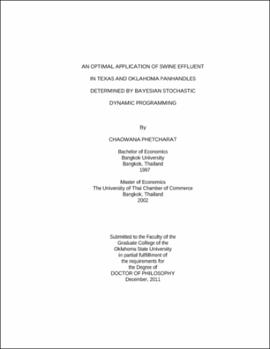| dc.contributor.advisor | Stoecker, Arthur | |
| dc.contributor.author | Phetcharat, Chaowana | |
| dc.date.accessioned | 2013-11-26T08:22:04Z | |
| dc.date.available | 2013-11-26T08:22:04Z | |
| dc.date.issued | 2011-12 | |
| dc.identifier.uri | https://hdl.handle.net/11244/6534 | |
| dc.description.abstract | Scope and Method of Study: The purpose of this study was to determine the most efficient time to apply swine effluent corn production in the Texas and Oklahoma Panhandle area. The effluent was assumed to be applied to a 128-acre corn field by a central pivot sprinkler irrigation system between April 1 and May 15. It was assumed that 48 hours were required to complete the application with the rate of 150 pounds nitrogen per acre. The mechanistic model developed by Wu et al. (2003a) was used to estimate the ammonia volatilization over the 192-hour period following application. Hourly weather forecast data were used in a Bayesian stochastic dynamic programming model to find the optimal time periods for effluent application. Markov transition matrices tracked the changes in forecast frequency from one day to the next. Total expected ammonia losses when applications were made with and without using weather forecasts were compared. The monetary values of the weather forecasts were estimated as the cost of additional nitrogen fertilizer to replace the nitrogen lost from nitrogen volatilization. | |
| dc.description.abstract | Findings and Conclusions: The simulated ammonia loss from the actual hourly weather data showed that 35% of ammonia applied would be lost when the application was made between April 1-5. The expected loss increased to 50% when the application was delayed until May 11-15. The expected nitrogen loss was reduced to 25% when the producer made an application only upon receiving a favorable weather forecast and was willing to operate the pivot for a six-hour period either day or night. If the producer applied effluent on a 12-hour day time only schedule but applied only after receiving a favorable forecast, the expected loss declined from 35 % to 30%. With nitrogen at $0.50 per pound, the value of the forecast information for a 128 acre corn field was $780 and $430 for the six-hour application and twelve-hour daytime-only application methods, respectively. There was a benefit of $463 for the 128-acre corn field from applying the effluent on a flexible six-hour day and/or night method as opposed to the 12-hour daytime only schedule. It is recommended the Wu model be incorporated into the Oklahoma Mesonet system using forecast weather data to provide producers with real time forecasts of nitrogen losses from effluent application. | |
| dc.format | application/pdf | |
| dc.language | en_US | |
| dc.rights | Copyright is held by the author who has granted the Oklahoma State University Library the non-exclusive right to share this material in its institutional repository. Contact Digital Library Services at lib-dls@okstate.edu or 405-744-9161 for the permission policy on the use, reproduction or distribution of this material. | |
| dc.title | Optimal application of swine effluent in Texas and Oklahoma panhandles determined by Bayesian stochastic dynamic programming | |
| dc.contributor.committeeMember | Vitale, Jeffrey | |
| dc.contributor.committeeMember | Boyer, Tracy | |
| dc.contributor.committeeMember | Warren, Jason G. | |
| dc.contributor.committeeMember | Hattey, Jeffory A. | |
| osu.filename | Phetcharat_okstate_0664D_11837.pdf | |
| osu.accesstype | Open Access | |
| dc.type.genre | Dissertation | |
| dc.type.material | Text | |
| dc.subject.keywords | bayesian method | |
| dc.subject.keywords | stochastic dynamic programming | |
| dc.subject.keywords | swine effluent | |
| dc.subject.keywords | weather forecasts | |
| thesis.degree.discipline | Agricultural Economics | |
| thesis.degree.grantor | Oklahoma State University | |
